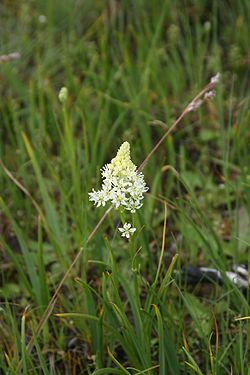Toxicoscordion venenosum
Zigadenus venenosus,Liliaceae, Death Camas, Meadow Death Camas, Common Death Camas
Contents
Taxonomy
Description
General: Glabrous perennial herbs from an onion-like bulb, the simple stem 2-5 dm. tall. Leaves: Leaves mostly basal, linear, keeled, 1-3 dm. long and 3-6 mm. broad; cauline leaves strongly reduced upward. Flowers: Inflorescence a raceme (but sometimes the raceme branched at the base) up to 1.5 dm. long, the flowers all perfect; perianth white to cream-colored, bell-shaped; tepals 6, unequal, the outer 4.5-5 mm. long, short-clawed, the inner about 0.5 mm. longer with a narrower, slightly longer claw; the gland at the base of each tepal yellowish-green, broader than long; stamens 6, about equal to the tepals; styles 3, distinct, 2-3 mm. long. Fruit: Capsule 8-15 mm. long.
Bloom Period
April-July
Distribution
British Columbia to Baja California, east to the Dakotas; more common west of the Cascades in Washington
Habitat
Ecological Setting Coastal bluffs and prairies, and moister areas of shrub-steppe and mountain meadows
Uses
Propagation
First Nations-Used as a violent emetic, sometimes mixed with blue flag; poultice of mashed roots applied to rheumatism, boils, bruises, sprains, sore legs, burns, swellings, rattlesnake bites, and broken bones to speed healing; mashed roots sometimes used as an arrow poison Other-This plant is highly toxic and can be weedy or invasive according to the authoritative source



